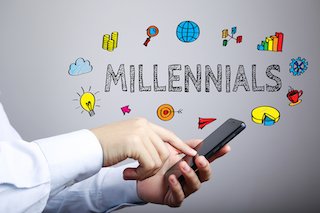Young and for the most part healthy, perhaps it’s not surprising that the vast majority of Millennials readily admit they would rather go without health insurance for a year than give up their cell phone.
And while research seems to indicate Millennials understand not having insurance coverage is risky, it hasn’t prevented them from remaining the most underinsured generation, according to recent data from Vertafore.
This obviously presents challenges for insurance agents who look to the Millennial generation (roughly those born between 1982-2000) as an important demographic when prospecting for new clients.
They’ll shell out about $600 on the latest iPhone and $120 a year for Netflix, but less than half will spend the $144 or so per year for renter’s insurance to protect their possessions. Even fewer will pay just over $150 a year (on average for healthy 30-year-old man) for a $250,000 20-year term life policy to protect loved ones – mainly because they think that much coverage would cost about $500 according to Life Happens data.
Heck, lots of Millennials don’t even think they can qualify for life insurance coverage. New LIMRA research shows that 41% actually believe this, which no doubt prevents them from even considering it.
Millennials will comprise more than 1 in 3 adult Americans by 2020, and will make up about 75% of the U.S. workforce by 2025, according to the Brookings Institute. As Millennials gather more and more wealth, their sheer size and unity of belief will shape the nation’s financial sector in the decades to come. That’s why it’s so important for the insurance market to reach Millennials with accurate information that dispels their misconceptions about cost and conveys the value of coverage.
What follows is a closer look at results of a new Vertafore study evaluating insurance sentiment and coverage rates of Millennials as it relates to their personal finance habits, as well as findings from two more recent studies.
The Vertafore survey of nearly 450 consumers ages 18 to 35 revealed that more than three-quarters (77%) of respondents understand not having insurance is risky, yet they remain the most underinsured generation – covered on average 14% less than older age groups across health, renters, home, life, and disability insurance.
Healthcare is top insurance priority but ACA repeal could impact coverage rates
Ironically, while a vast majority of Millennials (80%) have health insurance, prioritizing healthcare over all other forms of insurance, 88% admit they would rather go without health insurance for a year than give up their cell phone. With more than half (52%) of younger Millennials (18-25) now under their parent’s healthcare plan and at risk of losing coverage if the ACA is repealed, this could mean choosing between coverage or giving up favored Millennial luxuries such as Netflix, cell phones, or dining out.
Covered at a rate of 80%, Millennial respondents prioritize healthcare over all other forms of insurance. However, that rate of coverage could significantly change given that more than one-third (35%) of all Millennials aged 18-35 are either covered under their parents’ plan or purchase insurance through an exchange, both key components of the ACA. If the ACA were to be repealed, this group would be at risk of losing health insurance altogether.
Following the recent presidential election, one-fifth (20%) of Millennials cited feeling more at risk of losing their health insurance.

Insurance gap is putting Millennials at financial risk
Although a majority of Millennials believe insurance is complicated and expensive, they understand that not having insurance is risky. When evaluating rates of insurance coverage, however, a gap emerges between Millennial personal finance habits and the insurance they purchase.
The most significant disconnect in insurance coverage falls to Millennial renters, with more than half (58%) failing to purchase renters insurance. According to Allstate, the average renter in a two-bedroom apartment has $30,000 worth of personal belongings – property that would not be replaced in the event of a fire, flood, or break in.
When it comes to auto insurance, 17% of Millennial drivers were uninsured – 5% higher than the national average of 12% (according to the Insurance Research Council). This puts Millennials at greater risk, liable for thousands of dollars if held responsible for an accident, which at last count averaged anywhere from $9,300 per incident for property damage to $80,700 for a disabling injury (National Safety Council).
• As for disability insurance, older Millennials (26-35) were nearly two-and-a-half times more likely to purchase coverage than their younger (18-25) counterparts.
• A different recent study from Life Happens shed light on factors that prevent Millennials from seeking life insurance coverage. The biggest reason? The study found people ages 30 and younger think term life insurance costs three times more than it actually does.
In the study, when asked to estimate the cost of the yearly premium for a $250,000 20-year level term life insurance policy for a healthy 30-year-old, the median answer was $500. Life Happens says in fact it costs about $156. If more Millennials knew that, it stands to reason they’d be much more likely to consider carving out part of their budget for term life coverage.
Yet another survey backs up that Millennials are challenged when it comes to financial literacy. Research funded by the National Endowment for Financial Education® (NEFE) and conducted by George Washington University found most Millennials consider themselves far more knowledgeable financially than they actually are.
In the study, only 24% of respondents showed basic financial literacy, with just 8% showing a high level of knowledge. Yet, 69% gave themselves a high self-assessment of financial knowledge.
When push comes to shove, Millennials choose luxuries over insurance
Despite the common assumption that Millennials are irresponsible with their money, when comparing insurance purchases and personal finance habits, the survey reveals they buck the misconception and incorporate insurance into their budgets as financially able.
That is, unless that means giving up television streaming services such as Netflix, cell phones, or dining out. Additional personal finance insights include:
• Although renters insurance costs an average of just $144 annually, only 40% have purchased this type of insurance – indicating a stronger preference to spend $120 a year on television streaming services like Netflix as well as craft beer and spirits over coverage.
• Millennials are not all irresponsible – nearly 60% reported being unwilling to skip, delay, or temporarily stop paying for healthcare insurance if given the choice to save money.
• A majority (63%) of Millennials spend less than $300 a month on all forms of insurance, and more than half indicated they would invest in more insurance if they could afford it. Over 60% admit to spending more than $75 a month on eating out.
“Despite common misconceptions that Millennials are unaware and uneducated about insurance, our research clearly shows they value insurance but financial barriers and personal spending habits inhibit securing proper coverage,” said Bruce Winterburn, VP of Industry Relations at Vertafore. “Now is a great time for Millennials to align what they know to be true with the actions they take on insurance coverage. Their future finances depend on it.”
SEE ALSO: Millennial misconceptions of life insurance: A barrier to life ownership













